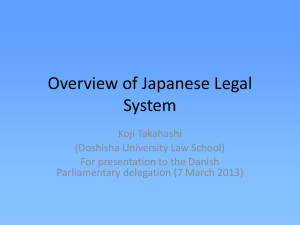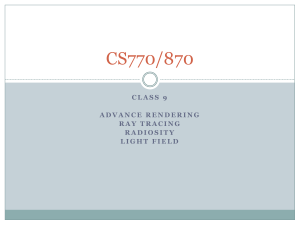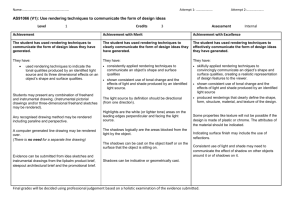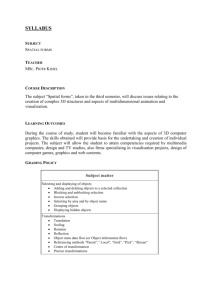Multi-Perspective Images for Visualisation
advertisement
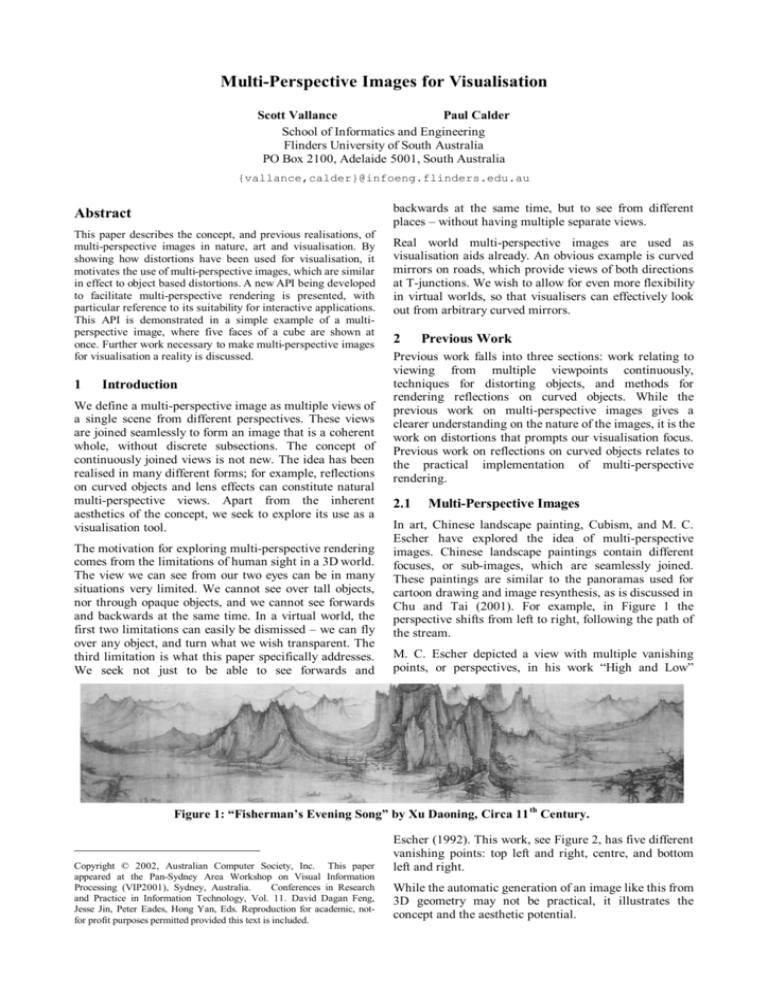
Multi-Perspective Images for Visualisation
Scott Vallance
Paul Calder
School of Informatics and Engineering
Flinders University of South Australia
PO Box 2100, Adelaide 5001, South Australia
{vallance,calder}@infoeng.flinders.edu.au
backwards at the same time, but to see from different
places – without having multiple separate views.
Abstract
This paper describes the concept, and previous realisations, of
multi-perspective images in nature, art and visualisation. By
showing how distortions have been used for visualisation, it
motivates the use of multi-perspective images, which are similar
in effect to object based distortions. A new API being developed
to facilitate multi-perspective rendering is presented, with
particular reference to its suitability for interactive applications.
This API is demonstrated in a simple example of a multiperspective image, where five faces of a cube are shown at
once. Further work necessary to make multi-perspective images
for visualisation a reality is discussed.
1
Introduction
We define a multi-perspective image as multiple views of
a single scene from different perspectives. These views
are joined seamlessly to form an image that is a coherent
whole, without discrete subsections. The concept of
continuously joined views is not new. The idea has been
realised in many different forms; for example, reflections
on curved objects and lens effects can constitute natural
multi-perspective views. Apart from the inherent
aesthetics of the concept, we seek to explore its use as a
visualisation tool.
The motivation for exploring multi-perspective rendering
comes from the limitations of human sight in a 3D world.
The view we can see from our two eyes can be in many
situations very limited. We cannot see over tall objects,
nor through opaque objects, and we cannot see forwards
and backwards at the same time. In a virtual world, the
first two limitations can easily be dismissed – we can fly
over any object, and turn what we wish transparent. The
third limitation is what this paper specifically addresses.
We seek not just to be able to see forwards and
Real world multi-perspective images are used as
visualisation aids already. An obvious example is curved
mirrors on roads, which provide views of both directions
at T-junctions. We wish to allow for even more flexibility
in virtual worlds, so that visualisers can effectively look
out from arbitrary curved mirrors.
2
Previous Work
Previous work falls into three sections: work relating to
viewing from multiple viewpoints continuously,
techniques for distorting objects, and methods for
rendering reflections on curved objects. While the
previous work on multi-perspective images gives a
clearer understanding on the nature of the images, it is the
work on distortions that prompts our visualisation focus.
Previous work on reflections on curved objects relates to
the practical implementation of multi-perspective
rendering.
2.1
Multi-Perspective Images
In art, Chinese landscape painting, Cubism, and M. C.
Escher have explored the idea of multi-perspective
images. Chinese landscape paintings contain different
focuses, or sub-images, which are seamlessly joined.
These paintings are similar to the panoramas used for
cartoon drawing and image resynthesis, as is discussed in
Chu and Tai (2001). For example, in Figure 1 the
perspective shifts from left to right, following the path of
the stream.
M. C. Escher depicted a view with multiple vanishing
points, or perspectives, in his work “High and Low”
Figure 1: “Fisherman’s Evening Song” by Xu Daoning, Circa 11 th Century.
Copyright © 2002, Australian Computer Society, Inc. This paper
appeared at the Pan-Sydney Area Workshop on Visual Information
Processing (VIP2001), Sydney, Australia.
Conferences in Research
and Practice in Information Technology, Vol. 11. David Dagan Feng,
Jesse Jin, Peter Eades, Hong Yan, Eds. Reproduction for academic, notfor profit purposes permitted provided this text is included.
Escher (1992). This work, see Figure 2, has five different
vanishing points: top left and right, centre, and bottom
left and right.
While the automatic generation of an image like this from
3D geometry may not be practical, it illustrates the
concept and the aesthetic potential.
Centre-Of-Projection images. One section of the
panorama can be from close to a portion of the image,
giving a high sampling for that area, while others are
further away and capture more of the object. Moving a
virtual camera through the scene generates the multiperspective panorama. At regular intervals the camera
captures a single line of pixels for the final panorama.
These lines, either rows or columns, are placed next to
each other, so that the viewpoint smoothly changes from
one to the next. This is effectively a virtual strip camera,
which is explained below. Figure 3 shows a MultipleCentre-Of-Projection image of an elephant. The virtual
camera path goes from one side of the elephant to the
other, and we can simultaneously see both sides and the
front.
Figure 3: Multi-Centre-Of-Projection image of an
elephant taken from Rademacher and Bishop
(1998)
Strip cameras are used in surveillance and mapping.
These cameras have a continuous roll of film that slides
past a slit as a picture is being taken. The camera may be
moved whilst the shooting, providing a change in point of
view from one section of the film to another. If used from
a moving plane these cameras can capture a long section
of curved earth as if it were flat. The cameras have also
been used for artistic purposes, capturing strange and
unusual images, such as in Robert Davidhazy’s work
(Figure 4).
Figure 2: "High and Low" by M. C. Escher
Hand-drawn and computer-generated panoramas with
multiple points of view have been used as the basis of
image resynthesis. Cartoon animation from panoramas is
an early example of resynthesis, which is explained and
adapted to computer-generated images in Wood,
Finkelstein, Hughes, Thayer and Salesin (1997). When a
small subsection of the panorama is viewed it
approximates a standard single viewpoint. If these
subsections are taken over a path on the panorama, they
give the appearance of motion when sequenced into an
animation. This is because the viewpoint shifts
continuously in a multi-perspective panorama.
Rademacher and Bishop (1998) present more generalised
multi-perspective images as the basis for resynthesis, the
advantage being a variable level of sampling without
multiple separate images. The paper calls these Multiple-
Figure 4: A strip camera image showing a head from
all sides taken from Davidhazy (2001)
In Loffelmann and Groller (1996) the idea of rendering
from multiple viewpoints with ray tracing is examined.
By developing an extended camera for ray tracing, the
authors present multi-perspective images with
visualisation as an application. Essentially an extended
camera is a set of 3D rays. Each ray has a starting
position and a direction, and these rays are used by a
conventional ray-tracer to draw the scene. Unlike a
conventional ray-tracer, these rays do not necessarily
originate from the same point.
2.2
Distortions
Distortions of the data, while being fundamentally
different in implementation than rendering multiperspective images, highlight the potential and
applications for multi-perspective images. Both seek to
present the data in a changed way so that previously
unseen properties become apparent.
Distorting an object to view it better is most commonly
illustrated with the Mercator projection. This takes a
sphere, generally the earth, and transforms it to a 2D map.
In this map directions are conserved, though sizes are not,
to allow for easy sea navigation. Although the distortion
of size is an artefact, it allows for a better understanding
of some aspects of the globe. This is ultimately the point
of distorting the data, either directly or by rendering
through a curved surface – to better illustrate certain
properties of the data.
Figure 5: A conventionally rendered set of columns
Figure 6: Columns rendered from a torus surface
Figures 5 and 6, both taken from Loffelmann (2001)
show the extended camera ray tracing in practice. The
first image is rendered normally, however the second is
rendered out of a torus camera. The rays used all start on
the surface of the torus and point in the direction of the
surface normal.
The extended camera is comprised of three sections: an
object space transformer, a picture space transformer and
a parameter space transformer. The object space
transformer is a function that returns the 3D start position
of a ray given its corresponding index on the 2D screen.
This function defines a surface in 3D, and the scene is
rendered “out of” this surface. Defining a multiperspective image from a rendering surface is a
convenient representation, so we have adopted it for our
work. A multi-perspective image could otherwise be
defined as a camera path, such as in Rademacher and
Bishop (1998) described previously. However, the
camera path can be described as a surface, and vice versa.
In Hurdal, Bowers, Stephenson, Sumners, Rehm, Schaper
and Rottenberg (1999) a scan of a brain was distorted into
a nearest approximation flat projection. This allows a
better appreciation of the layout of the brain from medical
imaging, with the intention of improving surgical
planning. This type of distortion is highly dependant on
the nature of the data, and does not translate well to the
visualisation of arbitrary scenes.
Distortion Orientated Displays are a general visualisation
tool based around the distortion of data. These displays
seek to show detail and context simultaneously. The
general problem is that when detail is shown, much of the
screen is filled with that detail. If the surrounding data is
shown at the same level of detail, it would not fit on the
screen. To accommodate this, in a distortion view there is
a region of focus at a certain detail level, which smoothly
transitions to a region of context at a lower detail level.
This can be seen in Smith (1997). Using a distortion
called a frustum display, the author was able to achieve
levels of detail sufficient for a city level road map, whilst
showing the context of the whole of Australia.
In 3D, both Keahey (1998) and Winch, Calder and Smith
(2000) expanded the idea of distortion orientated displays
to allow for regions of zoom – regions where the scene
data was expanded to a larger size. These prove useful for
highlighting sections of particular detail in a scene
without zooming and therefore cutting out periphery data.
The idea of detail and context is to have at least two
different perspectives on the data. In this case the
perspectives are not literal changes in viewpoint, but in
operating conditions. In Vallance and Calder (2001) the
idea of distorting a mainly planar world onto the inside of
cylinder was examined. This was proposed, in the
application of virtual maze navigation, so that two
different perspectives on the maze could be
simultaneously realised: a local view of the undistorted
maze walls, and a navigational view of the distant maze
perpendicular to the users viewpoint. Figure 7 shows an
example of the maze distortion.
the centre point in the direction of the reflected ray into
the cube. This approximation moves each reflected ray to
the centre of the cube. For scenes where the reflected
objects are far away from the reflective object the
technique works well; otherwise the approximation is
obvious. For the purposes of multi-perspective images
environment maps are not sufficiently accurate. The light
is sampled at only one point, making it unsuited for
multi-perspective, or multi-viewpoint, rendering.
Figure 7: A maze distorted in a cylindrical fashion to
show context
The cylindrical distortion works only because the data
lies mainly on a single plane. For arbitrary 3D data it is
unclear how the mapping onto a cylinder would be
helpful.
2.3
Reflections on Curved Objects
Reflections on curved surfaces are a natural form of
multi-perspective image. Computer graphics has long
been interested in realistically rendering virtual scenes
including reflections. Research into generating reflections
on curved objects, especially for real-time graphics,
shows how multi-perspective rendering can be
implemented. However reflections on curved objects are
a subset of multi-perspective images. Moreover they need
not be entirely accurate (they need only look appropriate)
and form only a small portion of the screen. Multiperspective images for visualisation have different
accuracy requirements and take up more of the screen.
Ray tracing is the most direct way to render reflections
from curved surfaces. When a ray intersects a reflective
surface it bounces off in a direction determined by the
angle of intersection with surface. Reflections drawn in
this manner are accurate, however ray tracing tends to be
very slow. Various methods exist for accelerating the ray
tracing. These methods range from reducing the number
of ray-surface intersection tests with hierarchal space
subdivision, to parallelising the calculations. Without
massively parallel hardware it seems unlikely real-time
ray tracing will be achieved soon, the problem is
discussed in Jansen (1993).
Environment mapping was initially suggested by Blinn
Blinn and Newell (1976), and is often used to
approximate curved reflections for real-time graphics.
When a scene is rendered from a particular viewpoint, the
light coming into that point is sampled. With enough
samples for a particular viewpoint, the technique can
approximate the colour of any ray shot from that point. A
popular implementation of environment mapping
involves rendering to the six faces of a cube centred on a
point. When used for generating reflections, this centre
point is the centre of the reflective object. For each ray
that bounces off the reflective object, a ray is shot from
An extension to the concept of environment mapping is
proposed by Cho (2000) to provide more accurate
images. Instead of simply sampling the light coming into
a point, a depth-mapped image is calculated for each of
the six cube faces of the environment map. Reflection
rays can then be traced into the 3D depth map, without
needed to approximate the start point of the ray. This
technique amounts to ray tracing the scene, though
through a modified representation of the geometry (the
depth map) that provides a significant performance
enhancement in some cases. Static scenes are required for
this technique, as otherwise the depth maps need to be
recomputed at each frame, which is very expensive. In a
multi-perspective image for visualisation, the surface will
be moving and not static in relation to the scene, so
extended environment maps would be unsuited.
Another type of technique based on environment
mapping is presented in Hakura, Snyder and Lengyel
(2001). In this technique, layers of environment maps are
used. Different environment maps may be used according
to the viewer’s location and direction of view, to avoid
the failings of standard environment maps. Once again,
this technique requires a static scene relative to the
reflective object to be effective. Rendering these
reflections from a series of stored images is actually
image based rendering. Other image based rendering
techniques, such as the Lumigraph (Gortler, Grzesczuk,
Szeliski and Cohen 1996) can be useful for rendering
reflections. These techniques represent the light in the
space of a scene, and are sampled with 2D slices to
generate a particular view. The drawback of such a
system is that it is currently not used for many
visualisation purposes, has a large memory overhead, and
needs an unchanging scene.
The most intriguing approximation of rendering
reflections on curved surfaces is described in Ofek and
Rappoport (1998). In this method, objects are
transformed by the reflective surface so that they may be
rendering from a single viewpoint. In essence the data is
distorted to an approximation of how it will look after
being viewed from a reflective surface, and then
rendered. It requires an appropriate tessellation of both
reflective surface and scene object so that lines that
should now appear curved do. The performance of this
technique is sufficient for real-time rendering of moderate
scenes. The technique works on standard polygon scenes
making it suited for visualisation tasks, and easy
integration into current applications.
3
An API for Multi-Perspective Rendering
In developing an API to facilitate rendering from multiple
perspectives the key concerns were:
EndSurface()
End a surface specification
block
Vertex(float x, y, z)
A vertex in the surface, the
exact meaning is dependant
on the type of rendering
technique
•
To separate, as much as possible, technique from
calling interface.
•
To allow easy integration into existing visualisation
applications.
Normal(float x, y, z)
•
Current normal for each
vertex
To allow for expansion of functionality and
techniques.
Viewport(float l, r, t, p)
The viewing dimensions of
the screen. Determines how
the surface is mapped to
the screen
To achieve interactive rendering of multi-perspective
images a variety of different techniques will need to be
evaluated. The API is designed to flexible enough so that
different techniques can be used without major changes to
the visualisation code that uses the API.
One of the most popular API’s for 3D graphics is Silicon
Graphics Inc.’s OpenGL. It provides a clear and powerful
set of instructions for building graphical programs. The
specification is described in Segal and Akeley (1998).
This API forms the inspiration for our design, and many
of the commands resemble OpenGL syntax. By basing
the API on OpenGL it should allow for easy integration
into existing visualisation programs that use OpenGL.
The multi-perspective rendering API covers two main
tasks: describing a surface to render from and a scene to
be rendered. Two abstract classes define the base level
interfaces provided by the API for these two tasks.
Geometry: Describes the scene to be rendered.
Functions
Description
Begin()
Start of a geometry
description block. Vertex,
normal and colour may
only occur between a
Begin() and an End()
End()
End of a geometry block
Vertex3f(float x, y, z)
Place a vertex of a triangle
in the scene with the
current normal and colour
Normal3f(float x, y, z)
Specify the current normal
Color3f(float a, r, g, b)
Specify the current color
Other
Various other commands to
specify textures and other
graphical properties
Surface: Describes the surface to render from.
Functions
Description
BeginSurface()
Start specifying a surface,
vertex and normal
commands may only
appear between a
Beginsurface and
Endsurface
These classes are accessed through the Renderer class,
which is a conglomeration of all the interface functions so
that they may be accessed without reference to particular
Geometry or Surface objects. The rendering technique
implemented in the Renderer class, which uses specific
Geometry and Surface objects to generate an image. This
is done so that the interface looks and feels more like
OpenGL.
These abstract classes are inherited by specific
implementations. For instance, the rendering of multiperspective images can be done with a ray tracer, the
surface can be specified as a set of rays and the geometry
as a set of triangles. This defines three classes that inherit
from the base classes: RayTraceRenderer, RaySet and
TriStore. Figure 8 shows the relationships of the classes.
The solid arrows indicate inheritance and the dashed
arrows show usage.
Geometry
TriStore
Surface
RaySet
Renderer
RayTraceRenderer
Figure 8: Diagram of base classes and a raytracing
renderer
In the surface class, like the geometry class, the main
mechanism for passing information to the lower level
rendering technique is the vertex and normal commands.
This symmetry is deliberate, so that, with the right
technique, a surface can be used to render from or to draw
with little modification. Also this OpenGL-style
immediate-mode specification of surfaces suits an
interactive application where the surface may be
changing from frame to frame.
The types of rendering surfaces that can be represented
easily with only vertex and normal commands is similar
to the types of conventional surfaces easily specified with
those primitives. Simple point-based geometry is
analogous to a simple rayset surface, where vertex and
normal commands denote a ray’s origin and direction.
Triangular patches are probably the most common form
of 3D geometry and rendering surfaces can also be
described in this manner. While polygon patches are not
curved, it is common practice to make them appear so by
interpolating properties between the vertices of the
constituent triangles. By taking the normal values at a
particular point as denoting the direction of a ray origin at
that point, and interpolating these normals between the
vertices, a graduated or curved surface is approximated.
4
Raytracing Implementation
As a first case implementation a ray tracing algorithm
was used, with rendering surfaces defined as a set of rays.
This implementation was used to render a simple scene
with a cube a tiled floor, shown here in Figure 9. While
basic, the scene has some properties that make it an
appropriate demonstration of multi-perspective rendering.
First the cube has six numbered sides, in a normal
perspective view at most three sides can be seen at once,
due to self occlusion. Second, the tiled floor provides a
reference to the effect of the rendering surface that is
easily perceived.
Parametric surfaces are also easily specified with vertex
and normal commands, with vertices interpreted as
control points of a patch. It is hoped that these different
ways of specifying surfaces will be sufficiently rich for
most purposes.
To illustrate how the API works here is an example based
on using the RayTraceRenderer described in Figure 8:
RayTraceRenderer rtr;
Figure 9: The cube scene
void SpecifySurface() {
rtr.Viewport(0,0,1,1);
rtr.BeginSurface(); {
rtr.Normal3f(0.0,0.0,-1.0);
rtr.Vertex3f(0.0,0.0,0.0);
rtr.Normal3f(0.0,0.0,1.0);
To simultaneously show five sides of the cube, a curved
surface is placed over the scene. This surface is
constructed initially from 16 control point Bezier patch,
which is decomposed in a set of rays. The surface can be
seen here in Figure 10, and is roughly hemispherical in
nature. Figure 11 shows the cube scene rendered through
the surface, with five of the cube’s faces visible.
rtr.Vertex3f(0.0,0.0,-1.0);
} rtr.EndSurface();
}
void SpecifyScene() {
rtr.Begin(); {
rtr.Normal3f(0.0,0.0,1.0);
rtr.Vertex3f(1.0,0.0,-1.0);
rtr.Vertex3f(-1.0,0.0,-1.0);
rtr.Vertex3f(0.0,1.0,-1.0);
} rtr.End();
}
Figure 10: A surface for visualising all sides of a cube
These functions, appropriate called, trace two rays into a
scene comprising of a single triangle. The RaySet and
TriStore objects are hidden by the RayTraceRenderer and
are accessed through that class.
The surface spans the cube scene, with the rays pointing
inwards in a direction normal to the surface. The
generation of the rays from the Bezier equations and
control points is a significant performance cost in itself.
Figure 11: The cube scene rendered from the surface
in Figure 10
Figure 13: An orthographic projection
The surface was constructed by manually entering
appropriate values for the Bezier control points. This is
undesirable from an interaction point of view, one of the
key aims of our research. As a first experiment in the
interactive specification of rendering surfaces, a 1dimensional control is proposed. A slider dictates the
amount of perspective on a normal rendering surface. A
zero value corresponds to an orthographic projection, and
the positive values correspond to an increasingly severe
perspective projection. Negative values correspond to a
‘reverse’ perspective projection where distant objects
seem larger, and closer objects smaller. Figures 12
through 14 show a perspective view, an orthographic
view and finally a ‘reverse’ perspective, respectively.
Figure 14: A ‘reverse’ perspective projection
Figure 12: A perspective projection
The floor of the cube scene appears to be upside down in
Figure 14, as the distant top edge is now larger than the
closer bottom edge. A simple 1-dimensional slider barely
captures the possibilities of interactively controlling the
rendering surface, but does allow for an evaluation of
such things as API design and system performance. The
OpenGL like multi-perspective rendering API is well
suited to interactively specified rendering surfaces
because the surface is specified in a manner similar to
that of dynamic geometry.
The rendering performance of the ray tracing
implementation of the API is too slow for interactive
performance. Frames take seconds to render each, even
over such a simple scene.
The ray tracing
implementation is admittedly naïve, and does not include
such common speedups as BSP culling of scene
geometry. The API is designed to easily allow for the
development and integration of new techniques, and these
are already being worked on.
5
Conclusions and Further Work
While the performance of the API in terms of frames per
second is far from interactive, the design and conceptual
groundwork has been laid for more detailed investigation
into multi-perspective images from visualisation. By
extending previous work on interactive reflections on
curved objects to multi-perspective images for
visualisation performance issues will be addressed. The
raytracing implementation described in this paper forms
an important base line for measuring the accuracy of
faster implementations.
The interactive manipulation of viewing surfaces is an
unexplored field, the simple 1-dimensional interaction
described here is a start, though things will be much more
complicated with more dimensions of freedom. Another
aspect this paper does not touch on is in the useful
application of multi-perspective images. The cube world
in Figure 11 demonstrates clearly one of our reasons for
pursuing multi-perspective images, the ability to see more
than is otherwise possible. With appropriate tools and
interfaces we believe multi-perspective images will be a
valuable tool for visualising complex data.
6
References
BLINN, J.F. and M.E. NEWELL (1976): Texture and
Reflection
in
Computer
Generated
Images.
Communications of the ACM, v19, n10, p542-547.
CHO, F. (2000): Towards Interactive Ray Tracing in
Two- and Three-Dimensions. PhD Thesis. University
of California at Berkeley.
CHU, S. H. and C. L. TAI (2001): Animating Chinese
Landscape Paintings and Panorama using MultiPerspective Modeling, Proceedings of Computer
Graphics International 2001, Hong Kong, IEEE Press.
DAVIDHAZY, A. (2001):, Peripheral Portraits and
Other Strip Camera Photographs, Retrieved October,
2001: http://www.rit.edu/~andpph/exhibit-6.html .
ESCHER, M. C. (1992): The Graphic Work. Evergreen,
Germany.
GORTLER, S., R. GRZESCZUK, R. SZELISKI and M.
COHEN (1996): The Lumigraph. In Proceedings of
SIGGRAPH 96, pp. 43-54.
HAKURA, Z., SNYDER, J., and LENGYEL, J. (2001):
Parameterized Environment Maps. In Proceedings of
the 2001 Symposium on Interactive 3D Graphics,
I3D01.
HURDAL, M. K., P. L. BOWERS, K. STEPHENSON,
D. W. L. SUMNERS, K. REHM, K., SCHAPER, D.
and A. ROTTENBERG (1999): Quasi-conformally flat
mapping the human cerebellum, in C. Taylor and A.
Colchester (eds), Medical Image Computing and
Computer-Assisted Intervention, Vol. 1679 of Lecture
Notes in Computer Science, Springer, Berlin, pp. 279286.
JANSEN, F. W. (1993): Realism in real-time? In
Proceedings Fourth Eurographics Workshop on
Rendering, Cohen, Puech and Sillion (eds).
KEAHEY, T. A. (1998): The Generalized Detail-InContext Problem. Proceedings of the IEEE Symposium
on Information Visualization. IEEE.
LOFFELMANN, H. and E. GROLLER (1996): Ray
tracing with extended cameras. The Journal of
Visualization and Computer Animation, 7(4): pp. 211227.
LOFFELMANN, H. (2001): Diploma Thesis, “Extended
Cameras for Ray Tracing”. Retrieved October 1, 2001,
http://www.cg.tuwien.ac.at/~helwig/projects/dipl/
OFEK, E. and A. RAPPOPORT (1998): Interactive
reflections on curved objects. In Proceedings
SIGGRAPH 98, pp 333-342.
RADEMACHER, P., and G. BISHOP (1998): Multiplecenter-of-projection images. In Proceedings of
SIGGRAPH 98, pp 199-206. ACM.
SEGAL, M., and K. AKELEY (1998): The OpenGL
Graphics System: A Specification (Version 1.2).
ftp://sgigate.sgi.com/pub/opengl/doc/opengl1.2/opengl
1.2.pdf
SMITH, R. (1997): Distortion Oriented Displays for
Demanding Applications. PhD Thesis, Gippsland
School of Computing and Information Technology,
Monash University.
VALLANCE, S. and P. CALDER (2001): Context in 3D
Planar Navigation. In Proceedings of the Australasian
User Interface Conference AUIC 2001, Queensland,
pp. 93-99.
WINCH, D., P. CALDER, and R. SMITH (2000): Focus
+ Context3: Distortion-orientated displays in three
dimensions. In Proceedings of the 1st Australasian
User Interface Conference AUIC 2000, Canberra,
Australia, pp. 126-133.
WOOD, D., A. FINKELSTEIN, J. HUGHES, C.
THAYER, and D. SALESIN (1997): Multiperspective
Panoramas for Cel Animation. In Proceedings of
SIGGRAPH 97 Conference, pp 243-250, ACM



